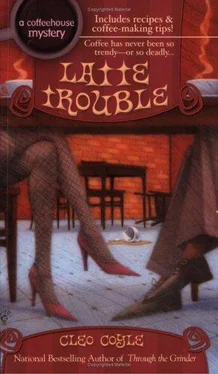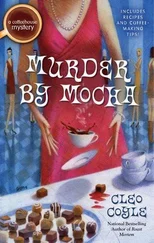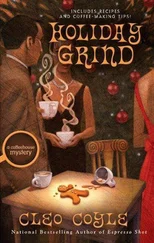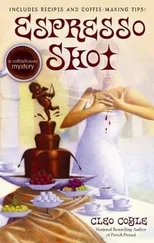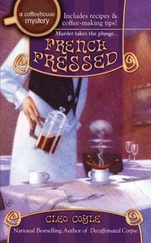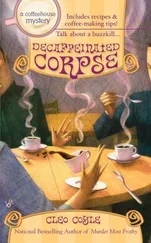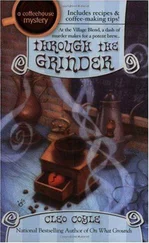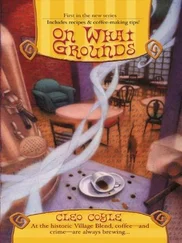Клео Коул - Latte Trouble
Здесь есть возможность читать онлайн «Клео Коул - Latte Trouble» весь текст электронной книги совершенно бесплатно (целиком полную версию без сокращений). В некоторых случаях можно слушать аудио, скачать через торрент в формате fb2 и присутствует краткое содержание. Год выпуска: 2005, ISBN: 2005, Издательство: Berkley, Жанр: Детектив, на английском языке. Описание произведения, (предисловие) а так же отзывы посетителей доступны на портале библиотеки ЛибКат.
- Название:Latte Trouble
- Автор:
- Издательство:Berkley
- Жанр:
- Год:2005
- ISBN:978-0425204450
- Рейтинг книги:3 / 5. Голосов: 1
-
Избранное:Добавить в избранное
- Отзывы:
-
Ваша оценка:
- 60
- 1
- 2
- 3
- 4
- 5
Latte Trouble: краткое содержание, описание и аннотация
Предлагаем к чтению аннотацию, описание, краткое содержание или предисловие (зависит от того, что написал сам автор книги «Latte Trouble»). Если вы не нашли необходимую информацию о книге — напишите в комментариях, мы постараемся отыскать её.
Latte Trouble — читать онлайн бесплатно полную книгу (весь текст) целиком
Ниже представлен текст книги, разбитый по страницам. Система сохранения места последней прочитанной страницы, позволяет с удобством читать онлайн бесплатно книгу «Latte Trouble», без необходимости каждый раз заново искать на чём Вы остановились. Поставьте закладку, и сможете в любой момент перейти на страницу, на которой закончили чтение.
Интервал:
Закладка:
I caught a cab on Hudson and listened to Bollywood music on the cabbie’s sound system as the Sikh driver raced uptown. Traffic was light and I was soon climbing out of the cab in front of the New York Public Library’s flagship building on Forty-second Street. The pair of immense stone lions that guarded the cathedral-like front entrance stared impassively as I paid the fare and followed the wide sidewalk to the back of the massive structure, where a lovely patch of green sat nestled among the skyscrapers just one block east of Times Square’s blinding neon and crazy congestion.
Although this midtown space has been called Bryant Park since 1842, the area itself has endured a checkered history. In the 1970s, for instance, when Times Square was a haven of prostitution and pornography, Bryant Park was a blighted site of muggings and drug deals. But a decade-long effort begun in 1980 has totally transformed the space and redeemed its fallen reputation. A refuge of peace and calm, Bryant is a true urban park, full of historical monuments, gravel paths, green chairs, and even a jaunty carrousel.
Bordered by the Main Library to the east, the modern Verizon Building to the west, and a brace of skyscrapers north and south, this emerald rectangle—named after the poet William Cullen Bryant in honor of that man’s tireless efforts to create large garden parks in New York City—has, since its renovation, become a midtown mecca for nature-starved urban dwellers seeking sunshine, the feel of grass under their feet, the sounds of a free concert in spring and summer, or the glamour of Fall Fashion Week in early autumn.
I entered the park along a gravel path which paralleled one of the three flower beds bordering the shady north lawn. Along both the northern and southern sides of the park were twin promenades lined with tall London plane trees—the same species found at the Jardin des Tuileries in Paris. The long trunks and delicate leaves of these one-hundred to one-hundred and twenty foot trees lent the place a distinct European character—the illusion completed by the towering stone backdrop of the New York Public Library, standing in for the Louvre.
Because of Fashion Week, the entire south and west sides of the park were dominated by several huge white tents, the largest of which appeared sizeable enough to house an airliner. Along Fortieth Street, which had been closed to vehicular traffic for the duration of Fashion Week, large mobile homes lined the curbs, all of them brightly painted, and decked with signs and the logos of the designers who used them.
The sidewalks were crowded with people. Many were obvious fashionistas—designers, wardrobe specialists, makeup artists, and young apprentices—beautiful and vacuous-looking enough to be aspiring models themselves. They were easy enough to identify by their bright blue T-shirts with the Spring Fashion Week logos, and their identity badges hanging from yellow cords around their necks. As I passed a trailer marked Malibu Bitch Swimwear, a door opened and out came a poised thirty-something woman in a conservative business suit. She waved a clipboard and stepped onto the street. Like chicks following a mother hen, five tight-bodied models in the skimpiest of bikinis cat-walked across Fortieth Street behind her. They strolled through the park and into the largest tent.
With the warm Village Blend bags still in hand, I fumbled through my purse for the invitation. The location of Lottie’s display was “Plaza—Bryant Park, Sixth Avenue between Fortieth & Forty-second Streets.” I was here, but where was the “Plaza”?
I corralled one of the young women wearing a Fashion Week badge. “Is there a plaza around here?”
“There are three venues in Bryant Park,” she said by rote. “The largest tent is the Theater, the tent next to it is the Bryant. That round tent in the middle is the Plaza.”
“Thank you.”
A guard insisted I show my invitation at the door. He glanced at the card, smiled when I asked for directions.
“The Lottie Harmon exhibit is in the second wing. Go through the lobby, past the photo display, then make a right. There’s a sign at the door.”
The interior of the tent was as spotlessly white as the exterior—even the plywood interior sections that parceled out the space under the canvas were painted the same virginal color as the tent’s walls and ceiling. Massive fans circulated air, sending the canvas rippling. That movement, combined with the gentle rush of cool, fresh air, made the white tent feel as light and dreamy as the interior of a cloud.
The middle of the Plaza was dominated by a large display on portable standees—a photographic retrospective of past Fashion Week styles, divided by year. Though the tent was crowded, few of the guests were viewing the exhibits. Most were heading toward one of the four wings that radiated out from the central exhibit area, a security guard at each door.
I spied the familiar Lottie Harmon logo—the stretched L and H, tiny handwritten letters spelling out the rest of the brand name. The designer label was still using its original logo, created from Lottie’s own distinctive handwriting a quarter century ago. Inside the white-walled area, I spied Lottie herself, posed within a space filled with hundreds of photographs, large and small.
She’d traded her chocolate brown evening wear for a champagne colored blouse and pants. The outfit was completed by an elegant tawny “maxi-jacket” with cream stitching that fell to her calves. Her bright scarlet hair was piled on top of her head and around her neck hung a glistening necklace of semiprecious stones polished to look like rich, darkly roasted coffee beans.
Lottie was speaking quietly with a Japanese man, whose wizened face was framed by iron-gray hair. The man looked prosperous, a fine pinstripe suit, of the kind tailor-made in London, hugging his compact form. His interest in Lottie’s words was obvious, and he respectfully bowed each time she answered a question. When I entered, Lottie waved to me, but did not excuse herself. A few moments later, the man bowed deeply, then strolled back to the lobby.
Lottie hurried forward to greet me.
“Clare, I’ve hardly had time to breathe, but I so wanted to call.”
No doubt to deliver bad news , I thought. There goes the Blend’s big runway catering gig .
“We still have so much planning to do for the big runway show Sunday. But I’m counting on the Village Blend to serve lattes to the crowd. After your troubles last night, I wanted to make sure you can still do it because, really, there’s just no better way for them to understand the inspiration for my Java Jewelry than if they’re sipping one of your fabulous coffee drinks!”
Lottie laughed just then. It was that high-pitched, forced laugh she sometimes used. I didn’t know if it was a tick to cover her nervousness or something else entirely, but it never failed to unsettle me.
I tried to summon a reassuring smile. “I’m very glad you still want us there, considering all that’s happened…”
Lottie frowned. “Oh, yes, it was terrible. At first, I thought the man was having a heart attack or something.”
“I was looking for you afterwards,” I replied. “I wanted to apologize for ruining your party, maybe hurting the reputation of your accessory line.”
Lottie waved her arm. “Don’t be silly, Clare. In the fashion business, any publicity is good publicity. Back in 1980…or was it ’81?…a well-known lead singer of a superstar band overdosed on stage during a concert. He was wearing one of my Spangle pieces—you could see it clearly in the photos of the man being rushed to the hospital. After that night, I couldn’t keep that piece in stock!”
“So you weren’t…troubled?”
Читать дальшеИнтервал:
Закладка:
Похожие книги на «Latte Trouble»
Представляем Вашему вниманию похожие книги на «Latte Trouble» списком для выбора. Мы отобрали схожую по названию и смыслу литературу в надежде предоставить читателям больше вариантов отыскать новые, интересные, ещё непрочитанные произведения.
Обсуждение, отзывы о книге «Latte Trouble» и просто собственные мнения читателей. Оставьте ваши комментарии, напишите, что Вы думаете о произведении, его смысле или главных героях. Укажите что конкретно понравилось, а что нет, и почему Вы так считаете.
